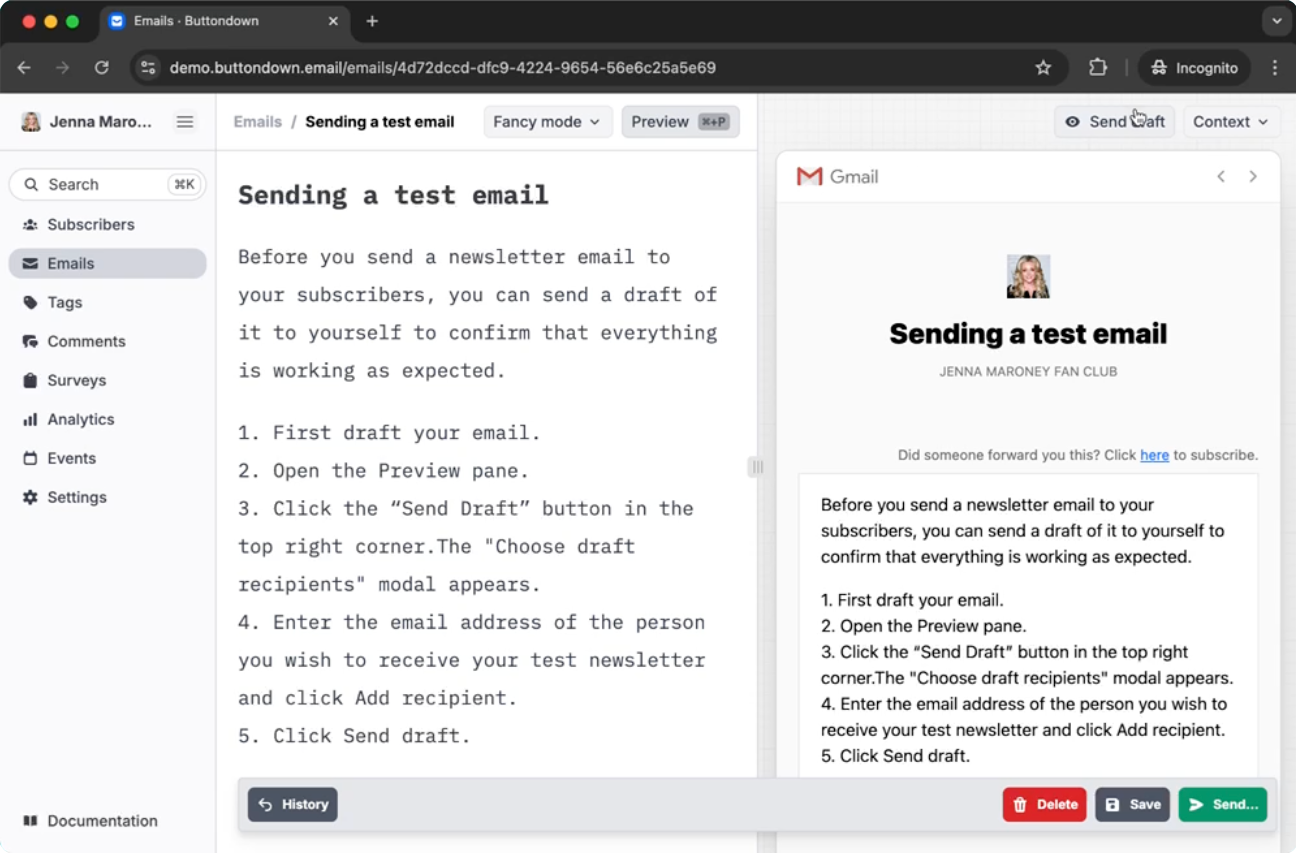
Buttondown is a member of the Open Source Pledge, where companies commit to contributing at least $2,000 per year for each developer on their team to open source maintainers. In this member spotlight we’ll look at who Buttondown is, what they do, and why they joined the Pledge.
When Justin Duke started building Buttondown, he didn’t really mean to start a company. He wasn’t trying to raise a bunch of money. He wasn’t chasing unicorns.
He just wanted a newsletter tool that didn’t feel broken.
“I was using this tool called TinyLetter,” he tells me. “I loved it. But they got bought in 2011; years later, it had just accumulated cobwebs. You could tell it hadn’t been touched in literal years. There were very, very obvious bugs.”
At the time, Justin was living in Seattle, sending a newsletter to a small set of family and friends to keep them in the loop about his life.
“I had used TinyLetter for years,” he explains. “And, well, finally I got to the point where I had the very terrible idea of building my own version of it.”
By day, he was working full-time as an engineer at Stripe. On nights and weekends, he was hammering away at this tool originally just meant to scratch an itch. Then, as things tend to go when you build something you need, others saw it and wanted it too.
“It was just meant to be this self-hosted thing.” says Justin. “But I would show people and they’d say ‘I’d use this! How much does it cost?’
“That… wasn’t really what I wanted to do.” he notes. “But it got to a point where I was like: ok, i’ll add a user table to the database. I’ll push out a janky MVP and iterate from there.”
“I’ll stop running it off my own laptop,” he laughs.
That was 2017. Fast forward to today, and Buttondown is a lean and still highly-focused platform powering newsletters for thousands of customers. The tool that inspired its existence has shuttered. The team has grown to a half-dozen-or-so full time employees, but they still haven’t raised venture capital – and not for lack of outside interest. It’s just not the way Justin wants to build his company.
A Different Kind of Company
“I owe my livelihood and career to the tech industry,” Justin tells me. “But if there’s one complaint I have about it, it’s that it’s fallen into a kind or feast-or-famine mindset, where you have this one possible correct end game: it’s an IPO/billion dollar exit, or it’s failure.”
"At first I just wanted to be able to sustainably draw a salary. Once I did that, I wanted to be able to hire people to do the work that I’m ill-equipped to do or don’t like doing. Then the goal was just being able to offer health insurance, and we hit that.”
“By being laser focused on what we do, we get to be one more data point that like… this is how a tech company can also work. If you build a product that is valuable to users, and those users pay you for that product, that is a very valuable and morally honorable existence. “
“Maybe that’s idealistic or something,” he notes. “But I feel like we’re entering an age where that is becoming more and more possible… and yet, somehow less acknowledged. To be able to run a company where people get to build something in service of something that they care about, and not have to worry about ‘How do we 10x this by this time next year?’… I just feel like more people who are talented engineers, or would-be founders, should consider it.”

Being more by doing less
If you’ve ever used any of the huge name newsletter/marketing tools, you’ve probably gotten lost in the user interface more than once. By trying to be something for everyone, they’ve boiled-the-frog on feature bloat to the point that they’re labyrinths.
By staying focused and lean, Justin says the team is able to build the product they want, instead of what everyone might want.
“We found a lot of success in selling customers on what we don’t have.”
Buttondown doesn’t do everything for you. It’s not supposed to. It’s opinionated. A bit scary, even, to those outside of the audience they’re trying to reach.
“Especially early on we’d deliberately reference Markdown on our landing pages – two or three times, very intentionally, as a sort of shibboleth.” notes Justin. “If you saw this little snippet of Markdown text and you’re terrified or you don’t know what it means: wonderful! Because Buttondown probably isn’t the tool for you. We’re meant to be relatively technical.”
“Don’t want to deal with a janky WYSIWYG editor? Great, write your own Markdown. We’d get customers from these huge platforms…they’d outright say “I’m leaving my old platform because they keep adding stuff I don’t need and charging me for it.”
“We found a lot of success in selling customers on what we don’t have,” he notes.
How Open Source makes it possible
Buttondown was one of the earliest companies to join the Open Source Pledge, committing to contribute at least $2k annually per developer on the Buttondown team.
Justin is very open about why: “None of the stuff that we do would be possible without the Open Source software we use.”
“My biggest competitor is a company with 20,000+ employees. The way we’re able to compete and build high quality software is by sitting atop all of these really, really strong Open Source frameworks, built by people who largely give their time and energy and lost sleep to make these things better. Django, Vue/Vite, and a long, long tail of really great single purpose packages… it’s just an entire universe of problems we don’t have to think about.”
“Prior to Buttondown I spent all of my time at bigger tech companies,” he clarifies. “The thing that I was never able to really square in my head was… all of this success, all of this revenue and growth, it’s downstream of these specific [Open Source] projects. It wasn’t even moral indignation; it was a sense of confusion: why aren’t we paying someone to help them work full time on this? Isn’t that just an obviously reasonable thing to do?”
“As soon as Buttondown was generating revenue, we found a way to make this work well within our margins. Even at the point where it wasn’t paying my salary — when it was just a nights and weekends thing — I would do the math and realize we were giving more to Open Source than many Series C companies with hundreds of employees. Why? It’s just wild.”
What’s next
Stories like Buttondown’s tend to be seen as anomalies — or, at least, they’re not the ones that pull the headlines. A solo founder, building something they need, growing at their own pace, waving away outside funding and any imposed grow-at-all-costs urgency.
Justin didn’t set out to build a company, but he’s ended up building one that generates real revenue, pays it forward, and proves there’s a very valid path in building thoughtful tools made by and for people who care.
And if they don’t take over the world? Justin’s okay with that. In fact, it’s the dream.
“If 10 years from now, 20 years from now, Buttondown is still here — maybe a little bit bigger, but still just a small company, laser focused on what we do… that’s really the happiest I would be.”